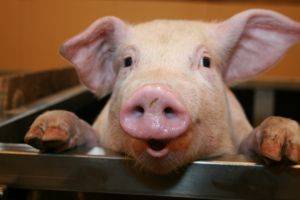pasteurellosis of birds
Pasteurellosis of birds, which is also called cholera, is a dangerous infectious disease of birds of all kinds, characterized by general septicemia and a high mortality rate of up to 90%. In most cases, the disease proceeds in the form of an epizootic and takes a stationary character. Pasteurellosis has also been reported in cattle , cats, and rabbits. Human infection can occur through contact with a sick bird through cuts and wounds on the skin, airborne droplets are not excluded.
The causative agent of the disease is Pasteurella multocida - short gram-negative, immobile, aerobic rods up to 2.5 microns that do not form spores. The main source of infection are sick and recovered birds. Pasteurella survive in bird droppings for a month, in water - 18 days, in inventory, down and feathers - up to 26-30 days. Carriers of the causative agent of pasteurellosis can be rodents, insects (mites, bugs, flies ), wild birds, animals of other species, as well as attendants.
All bird species are susceptible to P. multocida, although turkeys can be most severely affected. Chickens and turkeys are more often infected at the age of 70-120 days, ducklings - 45-50 days. Often the first sign of illness is dead birds. Infection occurs by aerogenic or alimentary routes. Considering that clinically healthy birds can be Pasteurella-carriers, any unfavorable factor (parasites, vaccination , deterioration in housing conditions) reduces the resistance of the bird and causes an outbreak of the disease. The pathogen is excreted from the corpses of dead birds, from the nose and with the feces of living birds, infecting the litter, feed, water, hatching eggs , inventory. From the gastrointestinal tract of an infected bird, Pasteurella is carried by blood, causing a severe septic process and intoxication.
The disease occurs in hyperacute, acute, subacute and chronic form. With a superacute course, the mass death of birds occurs suddenly without signs of illness, sometimes oppression and blue ridges are noted. In the acute course of the disease, cyanosis of the crest and beard, general depression, diarrhea mixed with blood, thirst, and fever up to 43 ° C are recorded. The subacute course is characterized by lethargy and inactivity of the bird, foamy mucus from the nasal openings and beak, wheezing, fever, thirst, diarrhea mixed with blood, cyanosis of the crest and earrings.
Birds surviving the acute septicemia stage, or birds infected with organisms of low virulence, may develop a chronic form of pasteurellosis characterized by localized infections involving the joints ., paw pads in birds, tendon sheaths, sternal bursa, conjunctiva, wattles, larynx, lungs, air sacs, middle ear, bone marrow and pia mater. Lesions resulting from these infections are usually characterized by bacterial colonization with necrosis and fibrinopurulent exudate.
Pathological anatomical autopsy of birds reveals pneumonia, pericarditis, duodenitis, foci of necrosis in the liver and myocardium. The disease is differentiated from Newcastle disease, salmonellosis, colibacillosis, mycoplasmosis, poisoning. The diagnosis of pasteurellosis is considered established if the pathogen is isolated and identified according to the results of laboratory tests.
According to the "Veterinary rules for the implementation of preventive, diagnostic, therapeutic, restrictive and other measures, the establishment and cancellation of quarantine and other restrictions aimed at preventing the spread and eliminating foci of pasteurellosis of various types", approved. By order of the Ministry of Agriculture of RUSSIA dated October 31, 2022 No. 770 (hereinafter referred to as the Rules), when a disease is established, restrictions are imposed on the farm, in the epizootic focus, all sick and suspected birds with pasteurellosis are slaughtered by the bloodless method. Feathers and down are dried in dryers at a temperature of 85°C for 20 minutes. or disinfected in a 3% formalin solution at a temperature of 45-50°C for 30 minutes. or in other disinfectant solutions with bactericidal activity against the pathogen,
Eggs before EXPORT from the farm, with the exception of hatching eggs, are subject to a single disinfection with formaldehyde vapor or other disinfectants that have bactericidal activity against the pathogen, according to the instructions for their use. Hatching eggs are subject to four disinfection with formaldehyde vapors for the first time no later than 1.5 hours after laying, the second - before laying in incubators, the third - after 6 hours of warming up in incubators and the fourth time - before hatching.
In accordance with the Rules, quarantine in poultry farms is canceled after the slaughter of all sick and suspected birds with pasteurellosis, vaccinationagainst pasteurellosis of birds without clinical signs characteristic of pasteurellosis, and other measures provided for by the Rules.
For the prevention of pasteurellosis, vaccination is carried out with live and dry avirulent vaccines. The implementation of preventive measures is mandatory: the creation of optimal conditions for keeping poultry; separate keeping of different age groups of birds; exclusion of contact of poultry with wild and rodents; timely culling of sick birds; import of hatching eggs only from prosperous farms; systematic disinfection of premises and equipment using approved preparations.
In order to protect themselves from infection at a poultry farm that is unfavorable for pasteurellosis, the staff must: use overalls, personal protective equipment; do not eat eggssick bird MEAT ; observe personal hygiene and comply with mandatory veterinary and sanitary requirements .
The material was prepared by specialists of the Department of Veterinary Medicine and Risk Analysis of Food Production of the Rostov Reference Center of ROSSELKHOZNADZOR.

